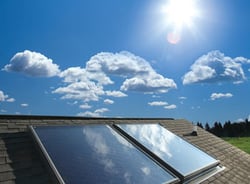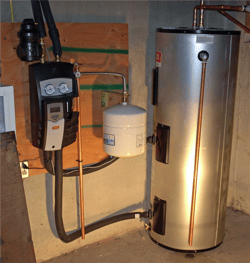 Home owners often ask me about technologies that can be installed in their homes to reduce both energy costs and their carbon footprint. Installing a solar water heating system is definitely an affordable way to "go green."
Home owners often ask me about technologies that can be installed in their homes to reduce both energy costs and their carbon footprint. Installing a solar water heating system is definitely an affordable way to "go green."
Solar water heating is a proven technology that works in all climates, even here in Central New York. With a solar water heater your water heating bills should drop 50 to 80 percent and, thanks to generous federal and state tax credits, payback can be realized in as little as three years
Solar water heating systems use the sun's energy as a source of heat to produce hot water for domestic use. There are two kinds of systems: active and passive. Active systems rely upon moving mechanical parts to transport heat. Passive units just use the sun to accomplish this action. Most systems installed in the United States are active because they're considered more efficient and attractive.
The system I recommend to home owners is the VELUX solar water heating system. It's an "active" system using low profile "roof integrated" solar panels that look just like skylights.
 Here's how it works. A residential solar water heating system uses one to three solar collectors on the roof which are approximately 4.5' x 6' each. The solar collectors contain copper tubes and a copper plate that is covered with a special coating. This assembly is enclosed in a well insulated aluminum frame and covered with tempered glass glazing. A solution within the copper tubes is heated by the sun and circulated through a heat exchanger located in the bottom of a solar storage tank in the home. Household water within the tank is heated by the solution circulated through the heat exchanger. Automatic controls operate a circulation pump and provide optimal solar water heating operation.
Here's how it works. A residential solar water heating system uses one to three solar collectors on the roof which are approximately 4.5' x 6' each. The solar collectors contain copper tubes and a copper plate that is covered with a special coating. This assembly is enclosed in a well insulated aluminum frame and covered with tempered glass glazing. A solution within the copper tubes is heated by the sun and circulated through a heat exchanger located in the bottom of a solar storage tank in the home. Household water within the tank is heated by the solution circulated through the heat exchanger. Automatic controls operate a circulation pump and provide optimal solar water heating operation.
The collectors work best when installed on a south-facing roof. The storage tank works most efficiently when installed near and under the collectors, but can be located up to 60 feet away.
Installed residential systems typically range from $9,000 to $13,000. Costs are determined by the following:
- The size of the family to be served
- Type of roof in which the panels are mounted
- Building code requirements
- Roof pitch and site conditions for the home
- Distance from the solar collectors to the storage tank
- Access to run new piping from the roof to the basement
Home owners can qualify for a 30 percent federal tax credit and 25 percent NYS tax credit. Coupled with energy savings, it's definitely an investment worth considering.